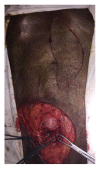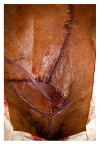Squamous Cell Carcinoma of Suprapubic Cystostomy Site in a Patient with Long-Term Suprapubic Urinary Catheter
- PMID: 29259836
- PMCID: PMC5702393
- DOI: 10.1155/2017/7940101
Squamous Cell Carcinoma of Suprapubic Cystostomy Site in a Patient with Long-Term Suprapubic Urinary Catheter
Abstract
Patients with long-term suprapubic cystostomy can rarely develop squamous cell carcinoma (SCC) of the suprapubic cystostomy tract. In addition to the few reported cases in the literature, this paper reports a case of suprapubic cystostomy SCC in an 88-year-old man without bladder involvement. Vigilance about any abnormal lesion at the site of suprapubic cystostomy is important among health providers and patients for early detection of SCC.
Figures








References
-
- Grignon D. J., El-Bolkainy M. N., Schmitz-Dräger B. J., Simon R., Tyczynski J. E. Squamous cell carcinoma. In: Eble J. N., Sauter G., Epstein J. I., Sesterhenn I. A., editors. World Health Organisation Classification of Tumours. Pathology and Genetics of Tumours of the Urinary System and Male Genital Organs. Lyon, France: IARC Press; 2004. pp. 124–126.
Publication types
LinkOut - more resources
Full Text Sources
Other Literature Sources
Research Materials

